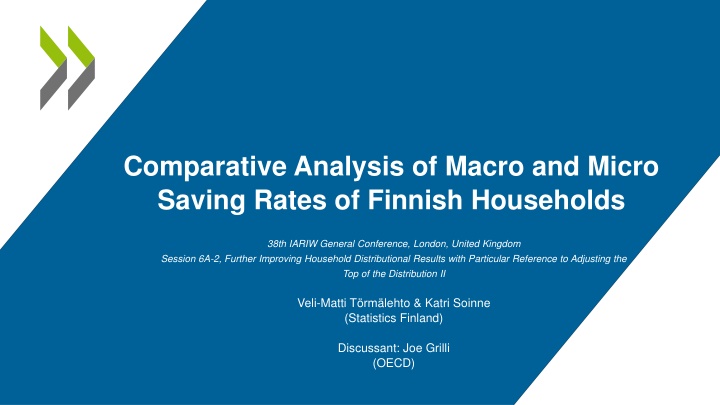
Analysis of Finnish Household Saving Rates Discrepancy
Explore the disparities between macro and micro saving rates of Finnish households, revealing lower macro rates compared to micro data. Discover the causes and implications of these variations, shedding light on the challenges in estimating household savings accurately.
Uploaded on | 1 Views
Download Presentation

Please find below an Image/Link to download the presentation.
The content on the website is provided AS IS for your information and personal use only. It may not be sold, licensed, or shared on other websites without obtaining consent from the author. If you encounter any issues during the download, it is possible that the publisher has removed the file from their server.
You are allowed to download the files provided on this website for personal or commercial use, subject to the condition that they are used lawfully. All files are the property of their respective owners.
The content on the website is provided AS IS for your information and personal use only. It may not be sold, licensed, or shared on other websites without obtaining consent from the author.
E N D
Presentation Transcript
Comparative Analysis of Macro and Micro Saving Rates of Finnish Households 38th IARIW General Conference, London, United Kingdom Session 6A-2, Further Improving Household Distributional Results with Particular Reference to Adjusting the Top of the Distribution II Veli-Matti T rm lehto & Katri Soinne (Statistics Finland) Discussant: Joe Grilli (OECD)
Paper Abstract summary Estimates of Finnish household savings in macro data are much lower (0%) than in Finnish micro data (19%) or other similar countries. This paper outlines differences in concepts, sources and methodology to examine: 1. Why do Finnish households have lower saving rates than other similar countries in the macro data? 2. What causes the difference in micro and Household distributional accounts (HDA) saving rates? 3. Are negative saving rates in HDA realistic? Restricted Use - usage restreint
Motivation The paper outlines how net saving rate for Finnish households is much lower than the rates found in neighbouring countries, with the macro statistics reported being much lower than the rate in the summed micro data. Restricted Use - usage restreint
Motivation The paper outlines how net saving rate for Finnish households is much lower than the rates found in neighbouring countries, with the macro statistics reported being much lower than the rate in the summed micro data. Restricted Use - usage restreint
Data Sources The paper considers 3 sources for estimates of the household saving rate: 1. Micro: Data from administrative and survey sources. 2. Macro: National Accounts data for the household sector. 3. Experimental HDA data aligns micro data to macro data totals. Micro Macro Administrative and statistical registers Household Distributional Accounts (HDA) Income tax data, deductible expenses, etc. Sectoral National Accounts Statistics on Income and Living Conditions Survey (SILC) KNN matching (see paper annex) Household budget survey (HBS) Other external data sources Restricted Use - usage restreint
Income and Saving Household net disposable income is defined (SNA, EG DNA): (net) Disposable income = Operating Surplus + Mixed Income + Compensation of Employees + net Property Income Current Taxes net Social contributions + Social benefits in cash + net Current Transfers Consumption of fixed capital And savings are defined as: (net) Savings = (net) Disposable income + Adjustment for change in pension entitlements ( Household final consumption expenditure) The paper explores how differences in micro data aggregates and coverage of items relative to the national accounts may cause disparities between the data sources, as well as differences between countries. Restricted Use - usage restreint
Differences across Countries macro data The paper highlights two main features of the Finnish household sector that impact the saving rate compared to other countries, mainly: 1. Consumption of fixed capital. The difference between the net and gross saving rate is the 3rdlargest value in the OECD. 2. Statutory earnings-related pensions schemes. Most pensions in Finland concern social security pensions, which do not accrue an entitlement, while individual private pensions fall outside the non-financial accounts (Zwijnenburg et al. 2021) and employment-related pension contributions get recorded in the adjustment for change in pension entitlements. Household savings in other countries may therefore be more affected by the adjustment for the change in pension entitlements compared to Finnish households. This makes Finland more comparable to other countries but does not close the micro-macro saving gap. Restricted Use - usage restreint
Differences within Finland micro and macro data The paper identifies differences between the micro and macro data that might cause the gap in saving rates: 1. Consumption of fixed capital and tax-deductible expenditure. Tax data includes deductible expenses on capital, while national accounts measures consumption of fixed capital (using Perpetual Inventory Method), which differ in value and how they are distributed across households. 2. Realised capital gains. Macro statistics and HDA record the taxes on realised capital gains but do not record the gains as part of income (these are recorded in the revaluation account on an accrual basis). In the micro data, EU-SILC includes neither, while Finnish income distribution statistics include both. Excluding realised capital gains related items increases the macro gross saving rate 0.7% and reduces the micro saving rate by 1.7%. Restricted Use - usage restreint
Differences within Finland micro and macro data 3. Other minor adjustments: Alignment to private household population, reallocating non-income and wealth taxes in micro data to current transfers paid, resolving gap between micro data totals and national accounts totals. While income data comes from administrative sources and has high coverage (95% of disposable income), consumption data is taken from a survey and has lower rates (88%) and some missing items require imputation. The inclusion of imputed consumption items (not covered or poorly covered in the HBS) reduces the HDA saving by 3.7%. Following all the adjustments, the aligned micro saving rate is 16.7%, while the HDA is approximately 11.8%. This difference is consistent across household type, age, socio-economic status. Restricted Use - usage restreint
Saving Rates The paper examines what might cause negative saving rates in micro and HDA data: Excluded realised capital gains but including taxes on realised capital gains. Single one-off large consumption expenditure, and debt financing. Volatility in self-employed incomes. Student loans & inter-household transfers financing young expenditure. Imputed consumption items. However, despite the adjustments, significant negative savings persist in the bottom 4 deciles of the distribution and across other breakdowns. Restricted Use - usage restreint
Saving Rates Moreover, the distribution of negative rates is supported by: 1. Household self-reported ability to save following similar patters to proportion of households with positive savings in HDA. 2. Other countries report similar saving rates by quintiles to Finland (-41.6%, -7.3%, 1.4%, 8.1%, 21.4%). Restricted Use - usage restreint
Concluding remarks The paper concludes by outlining some of the key areas: - The main cause of differences in macro data saving rates between Finland and other similar countries is due to consumption of fixed capital and adjustments to pension entitlements. - However, even with corrections for these issues, the rates in the HDA data would still be well below micro data. - Adjustments for measurement of specific consumption items or household types also does not entirely close the gap in HDA and micro data saving rates. - Detailed tax data highlights the impact on the income distribution of instances where the tax base is not included in income (e.g. pensions, capital gains) but taxes are. Restricted Use - usage restreint
Comments - The paper provides a detailed account of the high-quality data provided by Finland in constructing measurement of inequality. - Sections 4 and 5 of the paper demonstrate the potential to breakdown the household sector by many categories and understand how they differ. - The paper would benefit from stronger conclusions regarding the motivation of cause of differences in saving rates and on plausibility of negative savings. - The motivation for the proposed treatment of realised capital gains as part of income appears to be that their current exclusion mis-represents the well- being of these households when looking at income? - If this is the case, should an alternative measures be proposed rather than (only) looking at income (and should it look to include income, consumption and wealth together)? - As people may benefit from holding gains each year, it may be better to look at information from the revaluation account and combine this with information from income? Restricted Use - usage restreint
Comments: Pensions in the National Accounts The recording of pension contributions and benefits depends on the type of scheme: - For social security pensions, they are only recorded in the non-financial accounts. - For individual private pensions, they are fully regarded as financial transactions. - For employment-related pensions, they are recorded in both, reflecting that they are part of income, but also affect the pension entitlements as accrued by households. The adjustment for the change in pension entitlements in deriving saving is needed to facilitate the recording of employment-related pensions both as part of income and as part of (dis)saving. E.g., a pension contribution lowers the income of a household and needs to be added back in, in deriving savings to reflect that this contribution is also accruing an entitlement. The section 3 adjustment removes this savings accrual. The adjustment is ensuring similarity in the treatment of employment-related and individual private pensions as they both accrue an entitlement. Restricted Use - usage restreint
Comments: Pensions in the National Accounts For a pensioner with no other income source: - If they retire with an individual private pension, disposable income would be 0 and dissaving would be equal to consumption. - If they have an employment-related pension, disposable income would be equal to the social benefit, but this would be cancelled out via the adjustment for the change in pension entitlement (which would be negative and equal to this amount). So, dissaving would again be equal to consumption. However, this does impact the savings rate because while the savings are the same, the disposable income differs, i.e., with the first household having no disposable income and the second one an income equal to its pension benefit. Gross saving as a percentage of GDP could avoid these denominator effects for comparability. For social security, there is no change in the entitlement because it is purely transfers with no accrual of an entitlement. Restricted Use - usage restreint
















